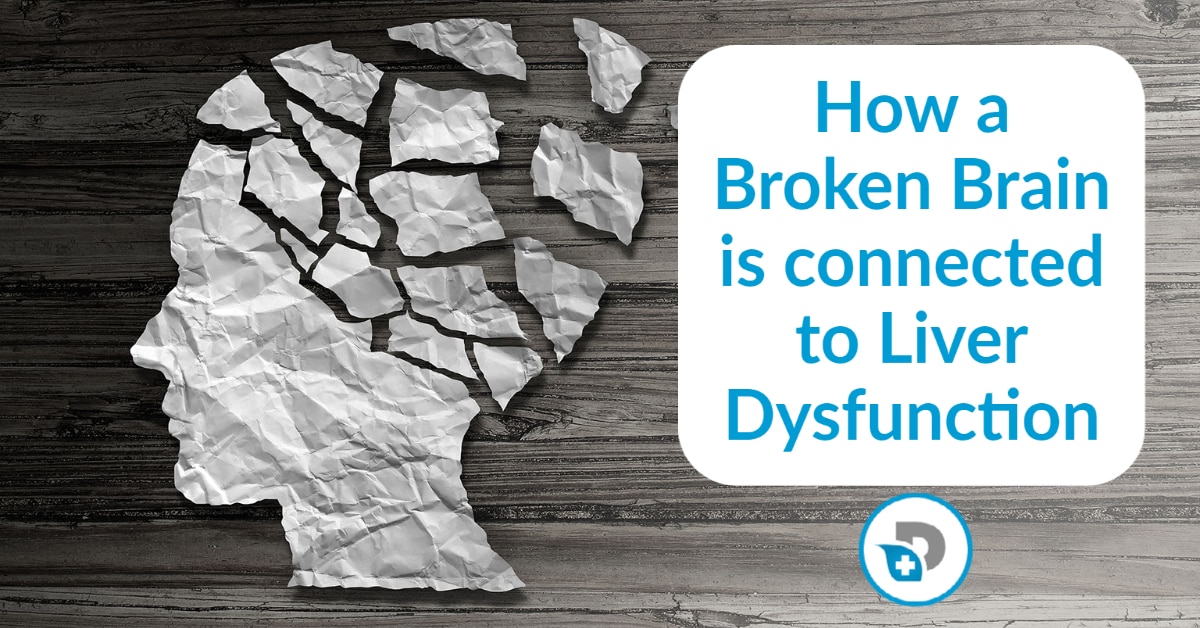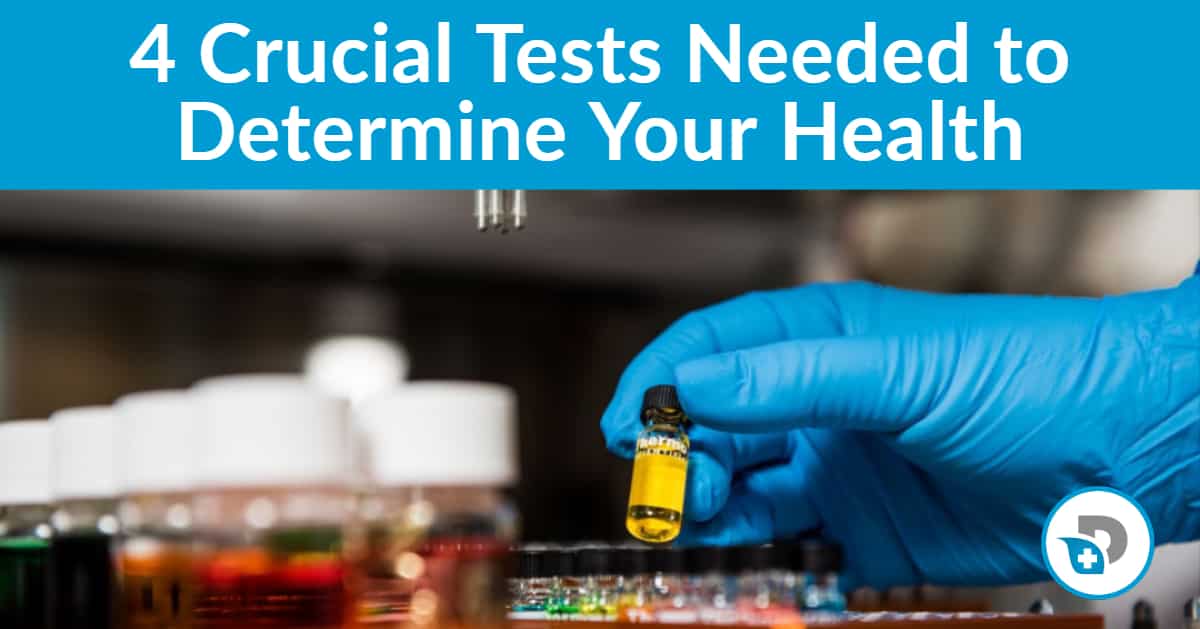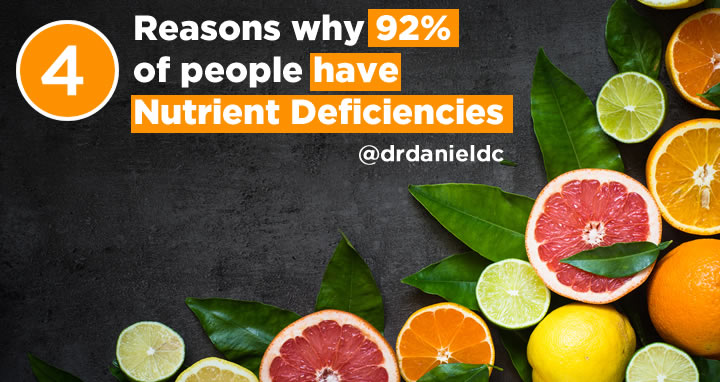
How a Broken Brain can be Caused by Liver Damage
-
by Dr. Daniel
- Published on

Liver Function and Brain Health
Did you know your liver can play a major role in neuro-inflammation? [1]
Over the last 10 years, it has become increasingly evident that peripheral organ-centered inflammatory diseases, including chronic inflammatory liver diseases, are associated with changes in the central nervous system (brain and spinal cord) and our behavior.
These behavioral changes include:
- Fatigue
- Cognitive dysfunction or decline
- General mood disorders (anxiety, panic & depression)
- Sleep disturbance
This is exactly why tending to liver function and detoxification is a vital part of any functional medicine approach to addressing chronic health conditions.
At the heart of liver function and brain health is systemic inflammation.
Systemic inflammation is when your body is producing pro-inflammatory chemicals that infiltrate and impact other parts of your body.
There are multiple causes of systemic inflammation including:
- Toxic Load (chemicals in our environment)
- Pathogenic Load (bacterial, viral, fungal and parasitic infections)
- Dietary Proteins (food sensitivities and allergies)
- Emotional/Physical Trauma (adverse childhood events, PTSD, etc.)
LPS produces three signaling molecules that have received the most attention in the Liver-Brain axis: TNFα, IL-1β, and IL-6.
What's interesting about these compounds is that you can inject them into otherwise healthy human subjects, and they develop sickness and behaviors associated with brain and cognitive decline. [2] [3] [4]
And when compounds that reduce or block these inflammatory compounds or signaling molecules are administered, there are improvements in such behaviors! [5] [6] [7]
In light of the current understanding, if your liver function is diminished, or if your detoxification pathways are impaired, brain dysfunctions are likely to occur.
Liver Detoxification Pathways
Liver detoxification involves making fat-soluble compounds water-soluble so they can be eliminated in urine, feces, or sweat.
Examples of compounds the liver metabolizes include hormones, over the counter and prescription drugs, and chemicals that are foreign to the body but still pass through liver detoxification pathways.
The liver has different detoxification pathways that make fat-soluble compounds water-soluble for elimination: Phase I, Phase II and Phase III.
Phase I pathway – Biotransformation
When a fat-soluble compound comes into the liver it first enters the “Phase I pathway.”
The Phase I pathway takes the compound in question and re-packages it in a way that prepares it for elimination. This is called biotransformation.
Phase I modification actually creates free radicals and oxidation which are harmful is your Phase II pathways are blocked.
Phase II pathway – Conjugation
Phase II has several different functions that further modify the compound known as: methylation, glucuronidation, sulfation, acetylation, and glutathione conjugation.
Once molecules are added to the compound in Phase II, it is heavy and stable enough to be eliminated from the body safely via poop, urine, breathe and sweat.
Phase III pathway – Elimination or Transport
This is where the body uses complex transport mechanisms to eliminate the toxins from the body.
All of these processes are dependent on the genes that control them working well and having the right nutrients in the right place at the right time.
For example, many people have problems with methylation and glutathione genes and those can mean that people are genetically weaker on those detox mechanisms.
The same goes for sulphation and acetylation – often people with multiple sensitivities have issues with those two pathways.
You can often get a clue of what might be weak from the type of things people are sensitive to: chemical sensitivity or people reacting to smells can be acetylation whereas a person with migraines might be having a sulphation problem and someone with high mercury or mold toxins is likely to have a glutathione issue as those block the gene expression.
True detox is ensuring this complex process is able to happen efficiently.
Signs & Symptoms of Liver Detoxification Problems
When a compound goes through Phase I it becomes more immune reactive and pro-inflammatory.
Under normal conditions, this is not a problem because Phase II reactions stabilize these immune reactive compounds.
However, inherited genetic traits or pre-existing toxic load can impact how these pathways work; which is one reason medications affect people differently.
Just because you have a genetic predisposition does not necessarily mean that gene will express itself, but factors such as diet or lifestyle can trigger these genes to turn on and off.
When a person’s liver Phase II pathway is hindered, three different possibilities exist.
- One is that an already inflammatory compound, such as an environmental toxin, is made more inflammatory in Phase I.
Because a hindered Phase II pathway is not capable of completing the job, this more toxic compound goes back into circulation, where it may activate the immune system and inflammation.
- The second possibility is that compounds that normally wouldn’t react with the immune system are metabolized into immune reactive compounds.
Increased toxicants due to failures in detoxification increase your risk of developing inflammatory conditions and autoimmunity.
- The third possibility is “re-toxing” because of dysfunctions in your skin, digestive system and kidneys.
If your elimination systems are not functioning well, you're not going to be able to eliminate toxins and they will accumulate.
How do you know if this is happening?
Signs of Poor Detoxification
The signs and symptoms of liver dysfunction are varied and may include the following:
- GI symptoms: constipation, nausea, bloating, flatulence
- Intolerance to fat, alcohol and caffeine
- Fatigue and lethargy
- Headaches / migraines
- Allergies and chemical sensitivities
- PMS and other hormonal imbalances
- Blood sugar swings
- Halitosis and body odor
- Cloudy urine
- Visual disturbances
- Fluid retention
- Sinus congestion
- Skin disorders
- Coating on tongue / swollen tongue
Strategies to Support Liver Detoxification
The first step is to reduce your toxic load.
This includes identifying and correcting sources of toxins such and bacterial infections, SIBO, intestinal permeability, mineral imbalances, heavy metals and environmental chemicals.
It should also go without saying that you should support the function of our liver.
This would include increasing healthy fats, improving fat absorption and gallbladder function and restoring glutathione levels.
Dietary guidelines to support Liver Detoxification
A detoxification or liver cleanse protocol should be considered whenever there is liver dysfunction.
This is normally anywhere from 2 weeks to 6 weeks, but may be longer in chronic conditions.
Bowel toxicity/gut dysbiosis and leaky gut should also be investigated as the gut is a major source of toxic exposure.
Juice-fasting delivers a high level of antioxidants but doesn’t provide all the factors needed for liver detoxification.
Similarly, water-fasting does not provide adequate substrates to support liver function.
A moderate detoxification program with clean, healthy, low-allergenic foods including healthy fats and protein will activate the Phase I and II detoxification pathways of the liver.
You also want to make sure that your digestive system is functioning well to allow for the elimination of toxins.
During a detoxification protocol, you should:
Avoid:
- Hydrogenated, refined and trans-fats
- Refined carbohydrates and sugar
- Allergenic foods, especially wheat and dairy
- Alcohol and caffeine
- All fried, junk, processed, refined foods
- Chemical additives
- Animal fats and protein (unless organic or grass fed), especially processed meats such as bacon, ham and sausages
- Large predatory fish
- Table salt
Increase/include:
- Organic, unrefined, whole foods
- Colorful fruits and vegetables and fresh vegetable juices: high in antioxidants
- Protein: mainly from organic animals or plant sources, small fish species and organic free-range poultry and eggs
- Soluble fiber: oat bran, pectin, psyllium, linseeds, chia
- Bitter foods: endive, radicchio, rocket, artichoke, turmeric, eggplant
- Sulphur-containing foods: eggs, garlic, onions, cruciferous vegetable, legumes
- Cruciferous vegetables: also contain indoles which protect DNA from damage, inactivate carcinogens and promote healthy metabolism of estrogen
- Turmeric: powerful antioxidant and inducer of Phase II enzymes
- Green tea: powerful antioxidant and inducer of Phase II enzymes
- Pure filtered water
- Antioxidants: protect the liver from free radical damage
- Vitamins C and E, beta-carotene, bioflavonoids, zinc, selenium, n-acetyl cysteine, CoQ10, curcumin
- Lipotrophic factors: promote the flow of fat and bile to and from the liver, as well as improving liver function and fat metabolism
- Choline – needed for methionine metabolism
- Methionine – prevents glutathione depletion
- Carnitine – inhibits alcohol-induced fatty liver disease
- Amino acids: methionine, taurine, glycine, cysteine Methylation factors: Needed for conversion of methionine to glutathione
- B6, folate, B12
Herbal/Botanical Supports for Detoxification
- Antioxidants to liver: St Mary’s thistle, turmeric, schisandra
- Liver protectives: St Mary’s thistle, bupleurum, turmeric, andrographis, dan shen, globe artichoke, rosemary, schisandra
- Liver restoratives: St Mary’s thistle, globe artichoke
- Phase I and Phase II detoxification increase: rosemary Gall bladder stimulants: barberry, blue flag, fringe tree, gentian, globe artichoke, greater celandine, yellow dock, dandelion, golden seal, milk thistle, turmeric
Lifestyle considerations to improve Detoxification
- Exercise: 30-45 minutes per day; enhances blood and lymphatic flow and facilitates clearance of toxins from tissues
- Avoid recreational drugs: including caffeine, alcohol and tobacco
- Minimize non-essential medications
- Replace toxic cleaning and personal care products with natural, organic alternatives
- Reduce stress
- Dry skin brushing: before showering to encourage skin detoxification
- Massage: especially lymphatic drainage massage to accelerate detoxification
- Saunas or infra-red saunas: promote eliminations through the skin
A Functional Medicine Approach to Liver Detoxification
References
- Butterworth RF. The liver-brain axis in liver failure: neuroinflammation and encephalopathy. Nat Rev Gastroenterol Hepatol. 2013 Sep;10(9):522-8.
- Capuron L , Miller AH. Immune system to brain signaling: neuropsychopharmacological implications. Pharmacol Ther 130: 226–238, 2011.
- Dantzer R , O'Connor JC , Freund GC , Johnson RW , Kelley KW. From inflammation to sickness and depression: when the immune system subjugates the brain. Nat Rev Neurosci 9: 46–56, 2008.
- Laye S , Gheusi G , Cremona S , Combe C , Kelley K , Dantzer R , Parnet P. Endogenous brain IL-1 mediates LPS induced anorexia and hypothalamic cytokine expression. Am J Physiol Regul Integr Comp Physiol 279: R93–R98, 2000.
- Jiang Y , Deacon R , Anthony DC , Campbell SJ. Inhibition of peripheral TNF can block the malaise associated with CNS inflammatory diseases. Neurobiol Dis 32: 125–132, 2008.
- Lichtenstein GR , Bala M , Han C , DeWoody K , Schaible T. Infliximab improves quality of life in patients with Crohn's disease. Inflamm Bowel Dis 8: 237–243, 2002.
- Tyring S , Gottlieb A , Papp K , Gordon K , Leonardi C , Wang A , Lalla D , Woolley M , Jahreis A , Zitnik R , Cella D , Krishnan R. Etanercept and clinical outcomes, fatigue, and depression in psoriasis: double-blind placebo-controlled randomised phase III trial. Lancet 367: 29–35, 2006.


